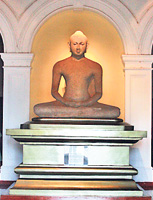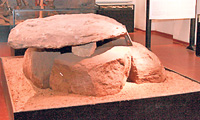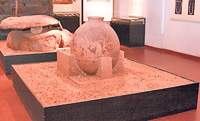The Colombo National Museum was opened to the public on January 1, 1877 its founder member being Sir William Henry Gregory who was the Governor of Ceylon at that time. The plan for the Museum was made by the government architect Mr. James G. Smither and he designed the plan in Italian
architectural style.
At the time of its
inauguration, there had been about 1200 antiquities and natural history
specimens. Colombo National Museum became very popular amongst locals as well as foreigners alike by 1940.
Its branches were opened in Jaffna, Kandy and Ratnapura
by the first
Sri Lankan Museum Director Dr. P.E.P. Deraniyagala and a fully-fledged Department of National Museums was established in 1942 consequently.
The collections that the Museum possessed
accumulated over the years and by the time it was
commemorating its 125th anniversary, the Colombo National Museum had over a hundred thousand
antiquities and natural
history specimens.
There are nine branches under the Department of National Museums.
They are;
- Colombo National Museum
- Natural History Museum
- Dutch Period Museum
at Colombo Fort
- Kandy National Museum
- Galle National Museum
- Ratnapura National Museum
- Anuradhapura Folk Museum
- Independence Memorial Museum at Torrington Square
- Galle Maritime Museum
 |
| Tholuwila Buddha
statue |
The Colombo National Museum building has its modern antiquities stores.
On the first floor of the Museum, the
artefacts are
displayed in nine galleries.
Gallery No. 1 is dedicated to the Pre and Proto
historic period which is based on
archaeological
evidence on human evolution; the
evolution in
Sri Lanka in particular.
The archaeological
evidence pertaining to human evolution in
Sri Lanka were collected from sites/caves such as Minihangalkanda (Hambantota), Pahiyanlena (Bulathsinhala Kalutara), Batadombalena (Kuruwita), Bundala (Hambantota), Alulena Athanagoda (Kegalle), Belilena (Kitulagala), Bellanbendipalassa (Ratnapura) and Manthai (Mannar).
The Second and Third Galleries are dedicated to the Anuradhapura and Polonnaruwa
periods
respectively, highlighting aspects such as agriculture,
irrigation, trade,
language and
literature, Buddhism and Hinduism that prevailed during these eras.
 |
| Ancient stone burial from Yatigalpotta Matale. |
 |
| Urn burial from Pomparippuwa used to place human ash. |
 |
| The oldest Pali palm leaf manuscript. |
The
Transitional
Period Gallery consists of
various
historical and archaeological evidence found during the Dambadeniya, Gampola, Yapahuwa, Kurunegala Raigama, Seethawaka, and Kotte periods. A significant
artefact found in this gallery is the oldest Pali palm leaf manuscript of the 13th century written in Sinhala characters.
A trilingual inscription
discovered from Galle in 1911, is yet another
important object found in this gallery.
Gallery No. 5 deals with the Kandy period – mainly its arts and crafts such as the Royal Seat, Royal Crown, the Royal jacket and watches etc., while in Gallery No. 6 all stone antiquities found from Anuradapura to Kandy periods are shown in three categories of Hindu
sculptures, Buddhist
sculptures, and inscriptions.
The urinals, doorways from Buddhist shrines, water filters, Ganesha and Vishnu
statues and
moonstones are some of the objects to name a few.
The Tholuwila Buddha
statue found in the lobby at the entrance to the Museum is a main
attraction. This statue was found in Tholuwila Anuradhapura in 800 A.D., and it depicts the Samadhi meditation pose of Lord Buddha.
In the upper floor of the Museum, galleries are based subject-wise like arts and crafts, coins and currency, arms and armaments,
standards and banners.
The Colombo National Museum is open to the
public from 9 a.m. to 5 p.m., on all days except on Fridays and public
holidays. Apart from
viewing the objects, the
public can also receive
assistance in terms of library services, and other educational guidance from its officers and lecturers for
researches, projects etc. |






